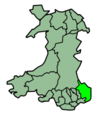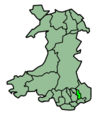Welsh Marches line
This article needs additional citations for verification. (November 2017) |
| Welsh Marches line | |
|---|---|
 An Arriva Trains Wales Class 175 approaching Craven Arms | |
| Overview | |
| Owner | Network Rail |
| Locale |
|
| Termini | Newport Crewe/Chester |
| Stations | 17 (Newport to Crewe) 15 (Newport to Chester) |
| Service | |
| Type | Heavy Rail |
| System | National Rail |
| Technical | |
| Line length | 84.38 miles (135.80 km) |
| Number of tracks | Double track throughout |
| Track gauge | 4 ft 8+1⁄2 in (1,435 mm) standard gauge |
| Operating speed | 60-90mph |
The Welsh Marches line (Welsh: Llinell y Mers), known historically as the North and West Route, is the railway line running from Newport in south-east Wales to Shrewsbury in the West Midlands region of England by way of Abergavenny, Hereford and Craven Arms and thence (by some definitions) to Crewe via Whitchurch. The line thus links the south of Wales to north-west England via the Welsh Marches region, bypassing Birmingham. Through services from south-west Wales, Swansea and Cardiff to Manchester (hourly in each direction) and from Cardiff to Wrexham, Chester, the north coast of Wales and Anglesey (every two hours in each direction) constitute the bulk of passenger operations on the route.
Welsh Marches line | |||||||||||||||||||||||||||||||||||||||||||||||||||||||||||||||||||||||||||||||||||||||||||||||||||||||||||||||||||||||||||||||||||||||||||||||||||||||||||||||||||||||||||||||||||||||||||||||||||||||||||||||||||||||||||||||||||||||||||||||||||||||||||||||||||||||||||||||||||||||||||||||||||||||||||||||||||||||||||||||||||||||||||||||||||||||||||||||||||||||||||||||||||||||||||||||||||||||||||||||||||||||||||||||||||||||||||||||||||||||||||||||||||||||||||||||||||||||||||||||||||||||||||||||||||||||||||||||||||||||||||||||||||||||||||||||||||||||||||||||||||||||||||||||||||||||||||||||||||||||||||||||||||||||||||||||||||||||||||||||||||||||||||||||||||||||||||||||||||||||||||||||||||||||||
|---|---|---|---|---|---|---|---|---|---|---|---|---|---|---|---|---|---|---|---|---|---|---|---|---|---|---|---|---|---|---|---|---|---|---|---|---|---|---|---|---|---|---|---|---|---|---|---|---|---|---|---|---|---|---|---|---|---|---|---|---|---|---|---|---|---|---|---|---|---|---|---|---|---|---|---|---|---|---|---|---|---|---|---|---|---|---|---|---|---|---|---|---|---|---|---|---|---|---|---|---|---|---|---|---|---|---|---|---|---|---|---|---|---|---|---|---|---|---|---|---|---|---|---|---|---|---|---|---|---|---|---|---|---|---|---|---|---|---|---|---|---|---|---|---|---|---|---|---|---|---|---|---|---|---|---|---|---|---|---|---|---|---|---|---|---|---|---|---|---|---|---|---|---|---|---|---|---|---|---|---|---|---|---|---|---|---|---|---|---|---|---|---|---|---|---|---|---|---|---|---|---|---|---|---|---|---|---|---|---|---|---|---|---|---|---|---|---|---|---|---|---|---|---|---|---|---|---|---|---|---|---|---|---|---|---|---|---|---|---|---|---|---|---|---|---|---|---|---|---|---|---|---|---|---|---|---|---|---|---|---|---|---|---|---|---|---|---|---|---|---|---|---|---|---|---|---|---|---|---|---|---|---|---|---|---|---|---|---|---|---|---|---|---|---|---|---|---|---|---|---|---|---|---|---|---|---|---|---|---|---|---|---|---|---|---|---|---|---|---|---|---|---|---|---|---|---|---|---|---|---|---|---|---|---|---|---|---|---|---|---|---|---|---|---|---|---|---|---|---|---|---|---|---|---|---|---|---|---|---|---|---|---|---|---|---|---|---|---|---|---|---|---|---|---|---|---|---|---|---|---|---|---|---|---|---|---|---|---|---|---|---|---|---|---|---|---|---|---|---|---|---|---|---|---|---|---|---|---|---|---|---|---|---|---|---|---|---|---|---|---|---|---|---|---|---|---|---|---|---|---|---|---|---|---|---|---|---|---|---|---|---|---|---|---|---|---|---|---|---|---|---|---|---|---|---|---|---|---|---|---|---|---|---|---|---|---|---|---|---|---|---|---|---|---|---|---|---|---|---|---|---|---|---|---|---|---|---|---|---|---|---|---|---|---|---|---|---|---|---|---|---|---|---|---|---|---|---|---|---|---|---|---|---|---|---|---|---|---|---|---|---|---|---|---|---|---|---|---|---|---|---|---|---|---|---|---|---|---|---|---|---|---|---|---|---|---|---|---|---|---|---|---|---|---|---|---|---|---|---|---|---|---|---|---|---|---|---|---|---|---|---|---|---|---|---|---|---|---|---|---|---|---|---|---|---|---|---|---|---|---|---|---|---|---|---|---|---|---|---|---|---|---|---|---|---|---|---|---|---|---|---|---|---|---|---|---|---|---|---|---|---|---|---|---|---|---|---|---|---|---|---|---|---|---|---|---|---|---|---|---|---|---|---|---|---|---|---|---|---|---|---|---|---|---|---|---|---|---|---|---|---|---|---|---|---|---|---|---|---|---|---|---|---|---|---|---|---|---|---|---|---|---|---|---|---|---|---|---|---|---|---|---|---|---|---|---|---|
| |||||||||||||||||||||||||||||||||||||||||||||||||||||||||||||||||||||||||||||||||||||||||||||||||||||||||||||||||||||||||||||||||||||||||||||||||||||||||||||||||||||||||||||||||||||||||||||||||||||||||||||||||||||||||||||||||||||||||||||||||||||||||||||||||||||||||||||||||||||||||||||||||||||||||||||||||||||||||||||||||||||||||||||||||||||||||||||||||||||||||||||||||||||||||||||||||||||||||||||||||||||||||||||||||||||||||||||||||||||||||||||||||||||||||||||||||||||||||||||||||||||||||||||||||||||||||||||||||||||||||||||||||||||||||||||||||||||||||||||||||||||||||||||||||||||||||||||||||||||||||||||||||||||||||||||||||||||||||||||||||||||||||||||||||||||||||||||||||||||||||||||||||||||||||
History[]
The line that exists today is the amalgamation of two lines, both with influence from the LNWR. The southern section from Newport to Hereford is formed from the Newport, Abergavenny and Hereford Railway, while the northern section from Hereford to Shrewsbury is formed from the joint GWR/LNWR Shrewsbury and Hereford Railway.[1] From Shrewsbury north to Crewe, the line runs over the LNWR-owned Crewe and Shrewsbury Railway.[2]
When the two railways arrived in the important market town of Hereford, the LNWR had already built Hereford Barton. The S&HR and the GWR agreed to build the Hereford Barrs Court, which was then also used by the Midland Railway's Hereford, Hay and Brecon Railway. After Hereford Council put pressure on the LNWR, they closed Hereford Barton to passengers, using it as a joint goods depot.
Under the 1960s Beeching Axe, many of the supporting branch lines were closed and the Hereford Barton loop closed. The remaining Hereford station was renamed Hereford Station and retains its Victorian Gothic architecture.
Route[]
The cities, towns and villages served by the routes are listed below from south to north:
- Newport
- connections with the South Wales Main Line and line to Gloucester
- Cwmbran
- Pontypool and New Inn
- Abergavenny
- Hereford
- connection with Cotswold Line to Worcester
- Leominster
- Ludlow
- Craven Arms
- connection with the Heart of Wales line to Llanelli
- Church Stretton
- Shrewsbury
- connection with Cambrian Line to Aberystwyth and Pwllheli, and the line to Wolverhampton.
- through services via the Shrewsbury–Chester line to Wrexham for trains to London Euston and Liverpool via Bidston, Chester then to Holyhead or Manchester Piccadilly.
- Yorton
- Wem
- Prees
- Whitchurch
- Wrenbury
- Nantwich
- Crewe
- connection with West Coast Main Line, and North Wales Coast Line to Holyhead (for ferries to Dublin)
- through services to Manchester Piccadilly
Services[]
Transport for Wales Rail Limited operate all passenger services on the line. Typically, there is an hourly service from Manchester Piccadilly to Cardiff Central, Carmarthen, Milford Haven, calling at principal stations. A service every two hours from Holyhead to Cardiff also uses the Marches line from Shrewsbury southwards. Additionally, local stopping services operate between Crewe and Shrewsbury and services via the Heart of Wales line use the Marches line between Shrewsbury and Craven Arms.
The line is very popular for railtours.
Great Western Railway[]
While the Marches line does not form any Great Western Railway passenger services, the operator moves its Class 800 (formerly HST) empty rolling stock 05:50 and 06:33 in the morning, and 22:10 and 23:38 at night along the Hereford to Newport section of the line, where stock returns to the Bristol Parkway Stoke Gifford IET Depot.
First Great Western formerly operated a limited service to Abergavenny as an extension of the service from London Paddington to Hereford, but this was withdrawn after just one year due to low usage.
See also[]
References[]
- ^ Cryer 2014, p. 26.
- ^ Cryer 2014, p. 28.
Sources[]
- Cryer, Geoff (2014). Shropshire Railways. Marlborough: Crowood Press. ISBN 978-1-84797-691-8.
Further reading[]
- Clark, Rhodri (8–21 October 1997). "The North & West - The jewel in South Wales and West's crown". RAIL. No. 315. EMAP Apex Publications. pp. 40–45. ISSN 0953-4563. OCLC 49953699.
- Allen, David (22 April – 5 May 1998). "Signalling the Marches Line". RAIL. No. 329. EMAP Apex Publications. pp. 34–39. ISSN 0953-4563. OCLC 49953699.
Gallery[]
| Wikimedia Commons has media related to Welsh Marches Line. |

The Welsh Marches Line at Craven Arms in Shropshire

Steam train approaching Harlescott Crossing near Shrewsbury

A Class 158 DMU running northwards from Shrewsbury in the direction of Crewe

Pontrilas railway station currently closed in the very long section without an intermediate station between Abergavenny and Hereford.
Coordinates: 52°5′14″N 2°41′23″W / 52.08722°N 2.68972°W
- Railway lines in Wales
- Railway lines in the West Midlands (region)
- Rail transport in Herefordshire
- Rail transport in Monmouthshire
- Rail transport in Shropshire
- Rail transport in Cheshire
- Rail transport in Newport, Wales
- Rail transport in Torfaen
- Railway lines in North West England
- England–Wales border
- Standard gauge railways in Wales
- Standard gauge railways in England









